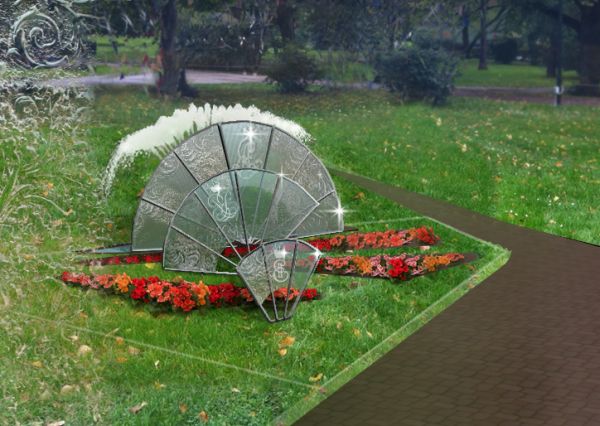|
|
Empress’ Fans

Annotation
Project concept: Empress’ Fans
Creator of the idea: O.A. Cherdantzeva, manager of the Imperial Gardens of Russia Festival.
Project manager: O.S. Fokina, General Director of Udachnij Proekt LLC
Development of the concept, design project, execution: O.S. Fokina, Y.A. Makarova, S.S. Tutanova, V.A. Krivtzov
If I rule the whole world,
I would like to wave it like a fan;
I would cool everyone with its zephyr
And would be the shield of the whole universe
And you, Chloe, waving me,
Breathing heavily in the heat,
Would shine red like the sun,
Being my beautiful shadow.
G.R. Derzhavin
The theme of this installation is connected with a collection of fans owned by the Russian Empresses, Catherine I, Elizaveta Petrovna and the daughters of the Emperor Peter I and Catherine the Great, whose reign was called the Golden Age.
We were inspired to create this exhibit project by a themed fan entitled “Holiday on the Water.” Its style demonstrates lightness and virtuosity, its colors are bright and striking. This elegant lady’s accessory, along with European dress, became fashionable among the most elite ladies during the reforms of Peter I in the early 18th century. The great flowering of the Russian fans began in the mid-18th century, especially during the reign of Catherine II.
The form of the fan supports the theme of gardens more better than anything else could; it can be found in nature itself— the elegant movement of fans in the hands of beautiful ladies, like flowers, like the luxuriant wings of birds and butterflies in an exotic garden.
Since its form is mutable, a fan is associated with the changing seasons, day and night, the phases of the moon, changeability and inconstancy.
The process of opening a fan illustrates the constant expansion of a person’s life experience, shifts, dynamics, development…
A fan can be used to send signals, it fills the air fills with the sounds of ardent confessions, coyness, doubt, jealousy and grief….
These emotions are also shown in the project in the form of three fans in various stages of openness, where, in the language of fan signals a fan open by less than a quarter symbolizes “modesty, uncertainly,” emotions characteristic for Catherine I during the rule of Peter. An opening fan indicates “approval,” which recalls the ascension of Elizaveta, and a fully opened fan indicates “unconditional, universal love,” the symbol of the rule of Catherine II.
Fan structures are not rare in historical gardens. Fan-shaped flowerbeds and lattices were always used to decorate gardens.
During our creation of these compositions, we considered the historical significance of the object, in harmony with contemporary trends, such as the use of glass, mater, water and color in architecture. The bluish tones of the specially made transparent glass used for elements of the fan indicate constancy and fidelity. The red fan made of flowers indicates joy and happiness. The fans are decorated with the monograms of the Empresses.
Furthermore, another aspect is represented in the project; references to the connection between the Summer Garden in Petersburg and the Kadriorgpark in Tallinn (formerly Revel), created by order of Peter for his spouse Catherine I and bearing her name.
The lightness and femininity of the compositions are emphasized by the flowing water that plays on the glass planes of the vans and recalls Peter I’s beloved fountains, which he placed in all of his gardens.
Partner:
Automated non-profit organization for continuing and continuing professional education
ST PETERSBURG INTERNATIONAL CENTER FOR LANDSCAPE DESIGN
GREEN ARROW
29, Millionnaya ul.,
St. Petersburg, 191186, Russia
Тел./факс: +7 (812) 312-86-82.
Тел. моб. +7 (812) 956-99-35; +7 (921) 302-27-63
E-mail:green-arrow@list.ru
www.zstrela.ru, зеленаястрела.рф,
vk.com/club8812942
LLC STUDIYA AVTORSKOGO STEKLA (DESIGNER GLASS STUDIO)
16 Pesochnaya Nab., Studio № 99
Russia, St Petersburg,
Tel.: +7 (911) 243-63-35; +7 (911) 934-15-57
www.avtorskoesteklo.ru
vkontakte.ru/club18767502
Designer glassware P. Biryukov, R. Biryukova;

